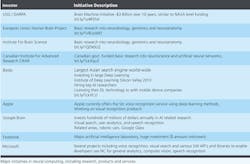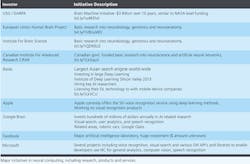The future of computer vision
Within 20 years, computer vision will be a commodity component within the fabric of the worldwide analytics infrastructure, similar to the telecommunications infrastructure of today, containing distributed analytics and databases services. Application-specific analytics and intelligence will be added to all devices by default within the Internet of All Things (IoAT), including visual, audio, textual, numerical and sensor analytics. A few new Neural Computing (NC) architectures will be standardized in silicon, applicable to all forms of data.
Major government and corporate initiatives are currently underway, similar to the space race, to create artificial brains which will contribute to the NC of the future. Future systems will contain application-specific mixtures of NCs, CPUs, GPUs, sensor processors, and IO. The underlying technology will be a near zero-cost commodity, and the revenue will come from services, similar to phone or cable services.
Imaging devices will be more accurate with more on-chip processing power for image processing and analytics. Image processing algorithms will be similar to those used today, with no major innovations expected. The computer vision community will standardize on a few feature descriptors and features learning architectures, enabling a generic NC platform for application-specific innovation and market growth.
Computer vision and analytics systems will be far superior to the primitive deep learning models in use today, combining deep-learning and multivariate wide-learning together, with improved feature descriptor models and comprehensive training protocols enabled by ubiquitous databases containing labeled samples of any type of image or data such as audio, textual, financial, and information about a person, place or thing. Personal privacy will virtually disappear.
Within 20 years, most mobile and hand-held devices will contain NCs connected to remote analytics services to enable personal, business, commercial, governmental, military, law enforcement and legal organizations to perform combined audio, visual, historical, and textual evaluations to enable shopping, tourism, employment interviews, banking, commerce, law enforcement or housing applications.
Neural computers will evaluate facial expression, body language and clothing style for emotions and intentions, as well as audio evaluation of the tone and rhythm of spoken words for latent intentions and assumptions, including analysis of the words from email, texts, blogs, and historical records from local governments, academic institutions, purchasing records, and other financial transactions.
The analytics will provide scenarios and what-if analysis and prediction of future behavior within a set of circumstances, for example allowing a commercial enterprise to design situations or opportunities to suit their preferences and influence purchasing behavior, or by allowing governments to develop policies and propaganda to test the reactions of a population, their preferences, intentions and personal beliefs.
Computer vision will be a central component of the future of the analytics infrastructure. Imagine government policy and business plans being designed around the predictions generated by an NC to form future programs and evaluation of each program by another NC to form recommendations, with the best recommendation being chosen by another NC to send to the final decision authority – a human...or an NC?
Principal Krig Research (Folsom, CA, USA; www.KrigResearch.com)


